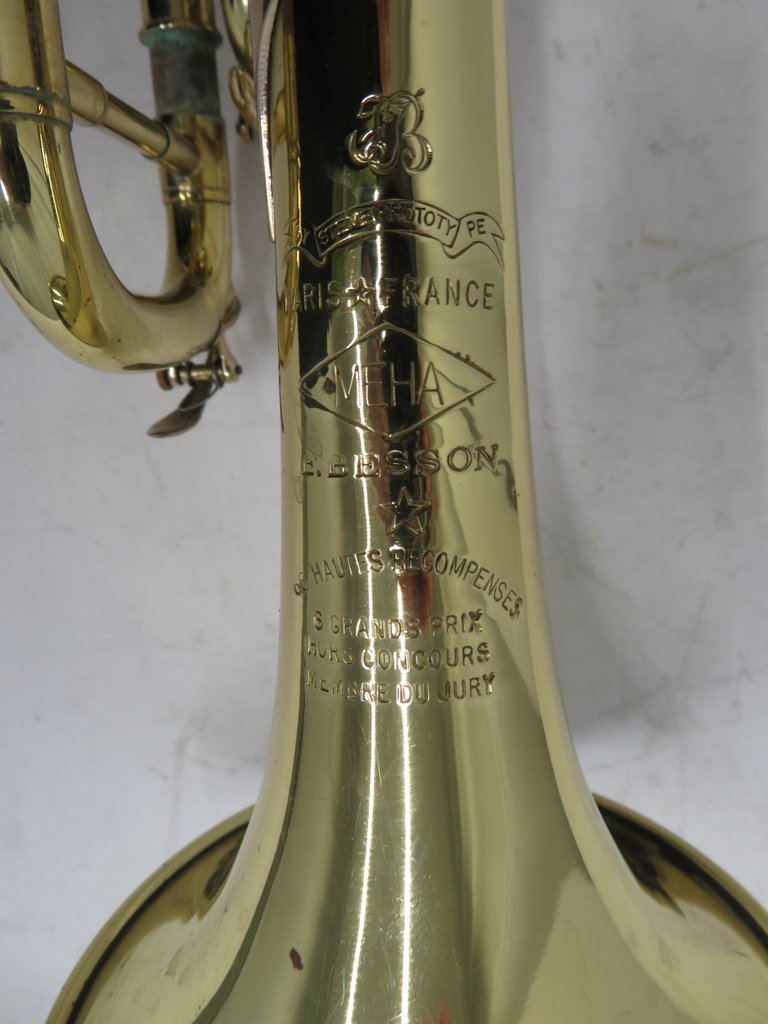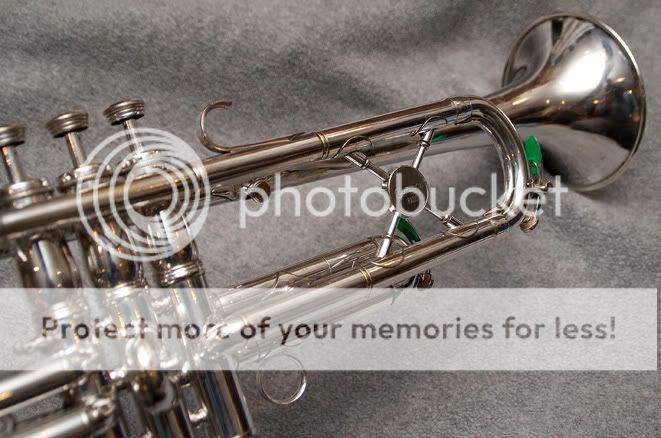| Genre | Musical instrument manufacturers |
|---|---|
| Founded | 1837 |
| Headquarters | |
| Parent | Buffet Crampon |
| Website | besson.com |
- Besson Euphonium Serial Numbers
- English Besson Trumpet Serial Numbers 588924
- French Besson Trumpet Serial Numbers
- Besson Trumpet Review
Besson is a manufacturer of brass musical instruments. It is owned by Buffet Crampon, which bought Besson in 2006 from The Music Group.

The company was formed in 1837 by Gustave Auguste Besson, who at the age of 18 produced a revolutionary design of cornet which surpassed all contemporary models. His products quickly gained a great reputation throughout Europe. In 1857, he moved to England where he built a large factory in London from which his instruments took a share of the English market and from where he exported to many countries including the United States.
- English Besson D Trumpet - Serial Number 2700xx. 0 bids Ending 6 Dec at 20:06 EST 8d 18h. Besson Eb Cornet Serial #14xxx (1969) C $258.21. 1 bid Ending 3 Dec at 10:32 EST 5d 8h. Besson Meha Kanstul Silver Plated Trumpet. C $132.56 shipping.
- The fake instruments, particularly pocket trumpets, cornets, euphoniums, bugles and B♭ trumpets, are likely to feature a 'serial number' of H.75983 (or 84059) embossed on the top of the bell and valve keys are often hexagonal in plan view.
- The serial number is 401000. The trumpet is in overall good condition but is being sold as-is for restoration. The lacquer is wore as seen but the rest of the horn is pretty solid.
- Used Besson Class A New Standard LP (low pitch) series. Serial number 219801 (1957). Used nice condition. Typical useage wear for a trumpet of 60 years old silver plated is 65%. All slides and valves are loose. A few small dents, In good playing condition. Supplied with original trumpetcase and standard mouthpiece. Please look carefully at each picture as photos speak a Thousand words.
The modern company produces a range of cornets, tenor horns, euphoniums, tubas, French horns and baritone horns. In its history, Besson also produced a number of other brass instruments, including a huge 'triple' B♭ tuba.
History[edit]
Again, by serial numbers the authenticate Besson Mehas start at 92,000. The most valued Meha’s are number from 92,000 to 100,000. After 100,000, the Besson Mehas were being built in London, with the infamous London valve casing.
In 1837, Gustave Auguste Besson (1820–1874) created the Besson brand in Paris with his new cornet. His instruments became famous in Europe, and he has been credited with over fifty inventions.[citation needed]
In 1858, following a long series of lawsuits with Adolphe Sax, Gustave-Auguste Besson left Paris to build a factory in London. Over the following years, Besson continued to manufacture in Paris and London, and also had warehouses for distribution in Brussels, Charleroi, Madrid and Barcelona. Following Gustave-Auguste Besson’s death in 1874, the company changed its name, becoming Fontaine-Besson in 1880 in France, and Besson in England.
At the same time, another English manufacturer was becoming well-known: Henri Distin, born in London in 1819.
Henry Distin and his new fluegel horn were active in the development of brass bands in England. He created a new line of instruments under his own name, and in 1872 the Distin brand was bought by Boosey (a music publisher since 1792, and a manufacturer of instruments since 1851). D.J. Blaikely, the inventor in 1878 of an automatically compensation tuning system for valves collaborated with Distin, and together they developed a new range and improved existing models.
In the 1930s in Paris, Strasser Marigaux and Lemaire, SML, all produced instruments for Besson with Aubertin. In 1957, Couesnon bought the French company Fontaine Besson.


In London, at the same time, Boosey & Co and Hawkes & Sons of England merged to create the group Boosey & Hawkes.
At the end of the nineteenth century (1894), the Besson factory of London employed 131 workers, producing 100 brass instruments a week, and no less than 10,000 musical ensembles appeared on their contact lists. In 1925, Besson purchased Quilter, and Wheatstone & Co. in 1940. In 1948, the group Boosey & Hawkes acquired the Besson London brand.
In 2003, Boosey & Hawkes separated from the cream of the crop in French wind instrument manufacturing, to join The Music Group. Sending private messages. In 2006, at the initiative of its CEO, Paul Baronnat. Buffet Crampon acquires two famous brass instrument brands, Antoine Courtois Paris (created in 1803) and Besson (created in 1837). The company became Groupe Buffet Crampon, with two subsidiaries, in the United States and Japan, and in November 2007, it appointed Antoine Beaussant as new Chief Executive Officer.
By joining the Buffet Crampon Group, Besson has restructured and relaunched its production of professional instruments in Germany and France. The Besson student instruments continue to be manufactured in the factory near Delhi, in India, under the supervision of specialists from the Buffet Crampon Group.[1]
Models[edit]
- Concertiste - Besson's most expensive model from the 1890s to the advent of World War I. The bowed-out shape of the Concertiste's intervalve portings is the design favoured today.[2]
- Desideratum - Besson's second most expensive model. The main difference in configuration between the Desideratum and the Concertiste models is the relationship of the leadpipe to the third valve slide.[3]
Counterfeit 'Bessons' instruments[edit]
A flood of very poor quality Indian-made[citation needed] instruments bearing the name Bessons entered the market in the late 1990s. They are unrelated to the Besson instruments manufactured by the company with that name. Many sales are made through online auctions. With cursory examination, any serious brass player would be able to recognise that these instruments are wholly inferior to real Besson instruments, and also of much poorer quality than even the cheapest of student instruments produced by reputable manufacturers.
The fake instruments, particularly pocket trumpets, cornets, euphoniums, bugles and B♭ trumpets, are likely to feature a 'serial number' of H.75983 (or 84059) embossed on the top of the bell and valve keys are often hexagonal in plan view. Similar counterfeit instruments, possibly made at the same factories, have been falsely branded with other reputable manufacturers' names, such as Getzen and Boosey. These instruments are best described as novelty items since they are shoddily built from very thin metal and they are often unplayable (due to faults in the manufacturing) and untunable (the tuning slides are simply ornamentation - they do not work).[citation needed]
Guitars[edit]
Besson guitars were produced in the 1950s. They were badged as Besson Aristone. These guitars were imported[where?] and often rebranded. Many of them were made by Framus. There was also a model made by Framus in the Besson name designed by jazz guitarist Jack Durante.
Besson Euphonium Serial Numbers
See also[edit]
English Besson Trumpet Serial Numbers 588924
- Harvard University Band, owner of a triple B flat Besson, one of the largest playable Tubas in the world
References[edit]
- ^Besson - our story
- ^Nicholas S. Thompson, François Tonneau Perspectives in Ethology: Evolution, Culture, and Behavior 2000 - Page 119 'Whereas the Concertiste was Besson's most expensive model, at least from the 1890s to the advent of World War I. the Desideratum was their second most expensive. Although the relationship of the intervalve portings to the placement of valve slides, and bell and leadpipe articulation to the valves, is geometrically identical in both the Desideratum and the Concertiste. the bowed-out shape of the Concertiste.'
- ^Brass Bulletin -2002 'À l'instar des cornets de Courtois (modèles 'Koenig', 'Arban', 'Levy' et autres) qui sont abondamment copiés dès le milieu du XIXe siècle, la plupart des facteurs de cornets s'inspireront des modèles 'Desideratum' et 'Concertiste' de Besson, ..'
French Besson Trumpet Serial Numbers
External links[edit]
- Big Tuba 2 Photo album of Sam Pilafian playing the Harvard Triple B-flat Besson tuba on October 8, 2004, as well as some close-up photos